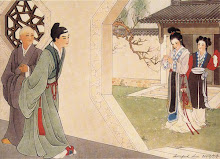21 May 2019
Kelin: beautifully brutal and bleak
Another Kazakh film that I watched recently was Ermek Tursynov’s 2009 art film Kelin (Келін), or Daughter-in-Law. In a nutshell: the cinematography of Kelin is amazing. The camera dwells lovingly on wide-angle shots of mountains and the taiga-to-tundra biome which the characters inhabit – not to mention the wildlife of sundry kinds (wolves, owls and vultures being the favourites). The period-specific props, costumes and make-up are simply exquisite. The soundtrack – khöömei throat singing and traditional flute and stringed instruments – is used sparsely and to effect. The acting, considering that the vast majority of the film has no dialogue whatsoever, is excellent. And the attractive Gulsharat Jubaeva (the actress who portrays the title character) provides ample eye candy for this heterosexual male viewer, anyway, spending several points in the film in candid love scenes and divers states of undress. But nonetheless: it is an intensely uncomfortable film to watch, and I can see why it sparked such controversy among Kazakh critics who saw the film as immoral and vulgar, even insulting. Riding alongside and underneath the marginal existence of the people and society portrayed in the film, is an undergirding of primordial atavism and barely-contained rage and violence.
WARNING: Spoilers to follow.
The titular kelin is being prepared to be married off by the women of her jüz, while the patriarch haggles with two prospective suitors – a hunter and a neatherd – over the bride-price. The neatherd makes the better offer, and the hunter goes off disappointed. The kelin runs after the hunter, who was her preferred suitor; he draws a knife and makes a blood oath with her. But her fate is sealed: she is taken by the neatherd back to his family – his brother and his mother. On the way, the neatherd brutalises the unwilling Kelin and forces her into sex. But after she spends some time in his home, she starts to enjoy his embraces, gets used to his home, and even starts to think she hasn’t fared too badly regarding her husband.
But her former lover, the hunter, returns and murders her husband in the woods, much to her and her in-laws’ grief when his body is found. They prepare her husband for a burial by exposure, and Kelin sees the hunter among the traders. Her feelings are decidedly conflicted when she meets him face to face. Kelin seduces her teenage brother-in-law, who had been interested in her since his brother first brought her home, but she finds the experience less than satisfactory. The hunter shows up again and seduces Kelin, but his efforts are discovered by Kelin’s mother-in-law – who begins to take measures against the two.
Kelin’s mother-in-law, who has shamanic abilities, ritualistically strips Kelin naked and cuts off her hair. She then pays a visit to the hunter, throws Kelin’s hair at him and puts a curse on him – but this does not deter the hunter from pursuing Kelin. He abducts her, but is discovered by Kelin’s mother-in-law and brother-in-law, who have different reactions. The brother-in-law confronts the hunter directly and picks a fight with him, stabbing him with a knife. The teenager loses the fight and is killed with his own blade; Kelin weeps over him but can do nothing. The mother-in-law flees to a mountaintop and begins chanting, causing an avalanche to fall over the trail where the hunter and Kelin are. The hunter sacrifices himself to save Kelin and is buried in the avalanche. When Kelin returns, her mother-in-law almost succeeds in strangling her to death, but discovers that she is pregnant and begins caring for her instead. The mother-in-law pampers Kelin, gathers herbs for her and assists in childbirth, and the two of them end up bonding over the baby. At the end of the film, the mother-in-law gives Kelin the staff she had used in her shamanic rituals – an understated but powerful moment of intergenerational solidarity. There is a strong implication in the final scene that the mother-in-law had gone through what Kelin had; but also that Kelin and her child would continue the same cycle.
End spoilers
The story of the film is fairly simple, and the motivations of the characters are straightforward enough so that the whole of the film, every emotion and action, can be carried effectively without dialogue. This lends the movie a visceral, raw and elemental core – a heroic-mythical weight and a broad common appeal that it might not otherwise have. The lack of dialogue combined with the broad, sweeping panoramic shots of the bleak tundra give us the distinct sense that this story is rooted in a timeless distant antiquity. One can be tempted to interpret it as a sort of cautionary tale about human nature generally. On the other hand, one can also interpret it as a movie about female endurance and survival – against the elements and against human violence. I am not surprised that many viewers thought the film was insulting to Kazakh culture, often portraying it as grim and brutal. But the female characters in particular demonstrate real spiritual strength through the various ordeals, even when they are pitted against each other by the harsh realities of their marginal lifestyle.
Even so, speaking personally – despite being well-scripted, brilliantly-executed and gorgeously-shot, Kelin is the sort of film I’m content to watch once, and I can see why it was considered controversial. I might recommend it to fans of art-house and wilderness-survival films both, but I can’t in good conscience recommend it generally.
Labels:
Adam and Eve,
Alash Orda,
culture,
heathenry,
movies,
Sibiir
Subscribe to:
Post Comments (Atom)














No comments:
Post a Comment